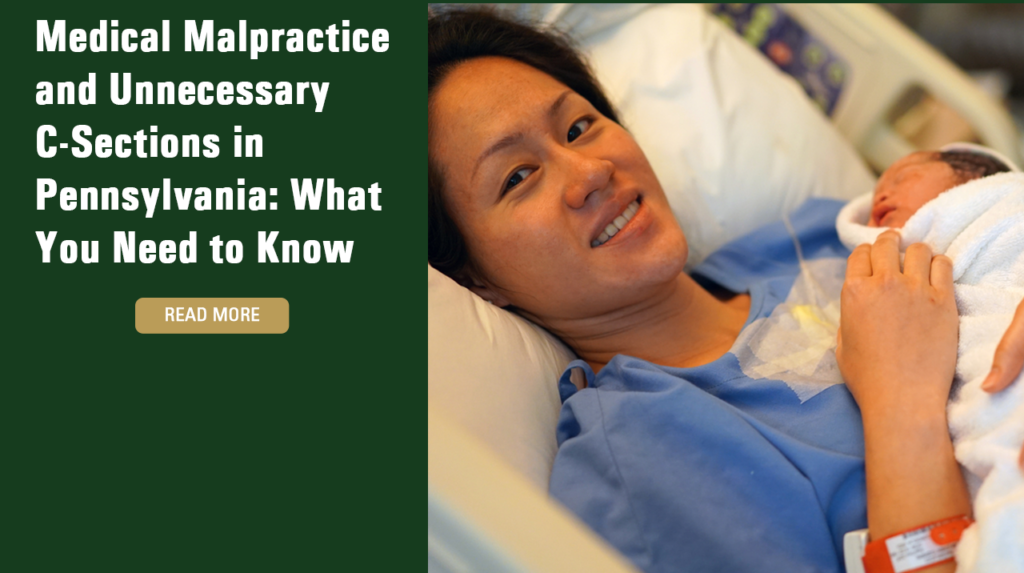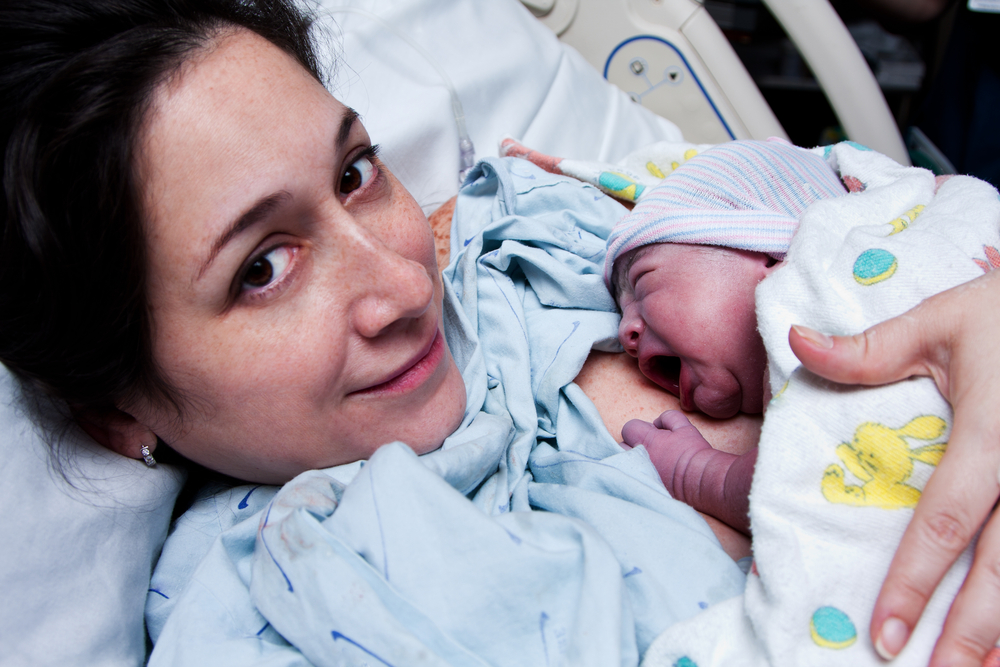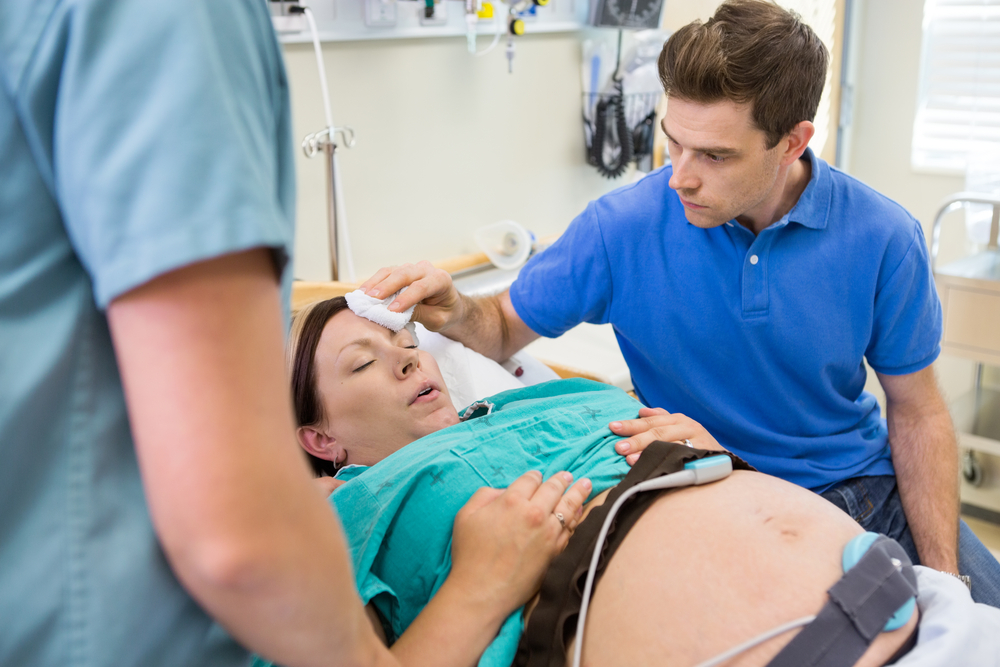Medical Malpractice and Unnecessary C-Sections in Pennsylvania: What You Need to Know

When pregnant women in Pennsylvania think about giving birth, they likely envision a vaginal delivery. However, Cesarean sections (C-sections) have become increasingly common in the U.S. Today, almost one-third of all deliveries are by C-section instead of vaginally.
C-sections have dramatically increased in Pennsylvania, and not all of them are necessary. In some cases, women who have undergone unnecessary C-sections might suffer serious injuries and have grounds to file medical malpractice birth injury lawsuits. If you are currently pregnant, you should research C-sections and talk to your doctor about them. You might end up having a C-section regardless of whether you prefer a vaginal delivery.
The rapid increase in C-sections in Pennsylvania should be questioned since these surgeries carry risks. Unnecessary C-sections could cause serious injuries to mothers and infants. According to a study published in the Canadian Medical Association Journal, women who underwent C-sections were 80% more likely to suffer complications than those who delivered babies vaginally.
When women receive unnecessary C-sections that result in maternal or neonatal injuries, they should consult an experienced labor and birth injury lawyer in Philadelphia at the law firm of Raynes & Lawn. Our PA medical malpractice lawyers dedicate themselves to holding doctors and hospitals accountable when they negligently cause harm to patients and can provide a fair evaluation of the viability of potential claims.
What Is a C-Section?
C-sections are surgical procedures used to deliver babies by making incisions in a pregnant woman’s abdomen and uterus. The incision cuts through tissue layers, abdominal muscles, and the uterine wall to expose the infant and allow for removal. The incision might be transverse or vertical. Women undergoing C-sections will be placed under anesthesia. In most cases, women will be given an epidural to prevent sensation in the abdominal region and legs. However, some women will be placed under general anesthesia.
Before the incision is made, the doctors should prepare the site by cleaning it with an antiseptic and placing a sterile drape around the incision site. The medical staff will raise a curtain between the woman’s chest and the incision site before the surgery. Women who receive an epidural will remain awake during the procedure, and the baby should be delivered in just a few minutes. However, things can go wrong during and after a C-section, and the recovery period is significantly longer than it is for women who deliver vaginally.
C-sections are only supposed to be performed when it’s not possible to deliver a baby vaginally or when doing so would be unsafe. They might also be indicated when the baby’s or mother’s health is at risk.
However, many C-sections are scheduled and performed when they are not medically necessary and when a vaginal delivery is both possible and safe. A C-section is major surgery and comes with a variety of risks. Performing an unnecessary C-section could expose the mother and baby to risks of serious injuries they might not otherwise suffer.

Risks of C-Sections
There are multiple known risks of C-sections that can affect both the mother and child. Women who undergo C-sections have a much higher risk of being injured or dying than those who deliver babies vaginally. Infants born by C-section also face substantially greater risks of birth injuries, respiratory issues, and death than babies who are delivered naturally.
C-Section Risks to Babies
Some of the risks infants face when delivered by C-section include the following:
- Respiratory problems – Infants delivered by C-section might develop respiratory issues caused by inhaling fluid into their lungs.
- Surgical injuries – Doctors might accidentally cut the infant when making the incision through the uterine wall and amniotic sac.
- Reduced immune response – Infants born by C-section are likelier to develop immune diseases because of the lack of exposure to good bacteria during vaginal birth.
- Long-term health implications – Neonatal exposure to oxytocin and anesthesia before a C-section could have long-term health consequences, including a higher risk of developing neurological disorders.
Risks of C-Sections for Mothers
Mothers undergoing C-sections face the following risks:
- Post-surgical infections – Following a C-section, women might have a higher risk of developing serious infections at the incision site, in the urinary tract, or in the uterine lining. The infection could spread and become septic, endangering the mother’s life.
- Excessive blood loss – Excessive blood loss during and after a C-section is a serious risk. In some cases, the mother could die.
- Anesthesia reactions and errors – Any time anesthesia is used, there is the potential for a serious reaction. In some cases, anesthesiologists might also administer too little anesthetic, making the mother experience severe pain during the surgery. In other cases, an anesthesiologist might administer too much anesthetic, which could interfere with the mother’s breathing and heart rate and could lead to death.
- Deep vein thrombosis – Women who undergo C-sections have a risk of developing blood clots inside of a deep vein within the pelvis or legs. If a clot breaks loose and travels to the lungs, it could block the flow of blood. This could be life-threatening.
- Surgical errors – In some cases, surgeons will accidentally cut the mother’s bowel or bladder while performing C-sections, which can lead to infections, require surgeries, and cause bowel and bladder issues.
- Higher complication risks in future pregnancies – Women who have C-sections have a higher risk of suffering complications during subsequent pregnancies. Women who have more than one C-section have a much greater risk of developing placenta previa or placenta accreta. In placenta previa, the placenta attaches too low in the uterus and partially or completely blocks the cervix. In placenta accreta, the placenta grows into the uterine wall instead of detaching from it.
- Uterine rupture – Following a C-section, women have a higher risk of uterine rupture in which the uterus tears at the site of the previous incision when they deliver vaginally instead of undergoing a second C-section.
C-section Trends
According to the World Health Organization, C-section rates should be up to 10% of births but shouldn’t be higher. The WHO found no reduction in maternal and neonatal mortality rates when the rates increase beyond that percentage.
However, the U.S. Centers for Disease Control and Prevention (CDC) reports that 32.1% of all deliveries in the U.S. are by C-section. Certain hospitals boast much higher C-section delivery rates than the national average. For example, live birth data reported by the Pennsylvania Department of Health reveals that Children’s Hospital of Philadelphia had a C-section delivery rate of 67% in 2018.
Between 2009 and 2021, the rate of C-section deliveries increased by 60% from 20.1% in 2009 to 32.9% in 2021. This increase was not correlated with higher incidence rates of conditions that should prompt doctors to perform C-sections. Instead, many of these surgeries were likely unnecessary.
Why Have C-Section Rates Increased?
C-Section rates have skyrocketed in the U.S. and around the world. According to the Harvard T.H. Chan School of Public Health, the rates have increased by 500% in the U.S. since the 1970s. During the 1970s, one out of every 20 babies was born by a Cesarean section. Today, nearly one in three are born by C-section. Researchers estimate approximately 50% of all C-sections could be avoided.
Multiple reasons why the rate of C-sections, including many that are unnecessary, has increased in the U.S. have been identified. A few myths also exist about the reasons for increased C-section rates. While some people believe that the increase is due to mothers choosing C-sections out of convenience, research has found that only 1% of mothers choose to schedule C-sections.
A second myth is that the high C-section rates are due to the increased number of older women giving birth. While it is true that more women are waiting to have babies until after they reach their 30s, research discounts this idea as a reason because the C-section rates have increased among women of all age groups, including younger mothers and those without identified health issues.
The third myth is that the high C-section rates are due to increasing liability risks. However, researchers have found that liability risks account for a very small percentage of C-sections performed in the U.S. Instead, C-section rates have skyrocketed dramatically while the rate of medical malpractice lawsuit filings has remained relatively the same during the same period.
The reasons behind the increase in C-sections in the U.S. are complicated and intermingled. Some of the reasons that have been identified include the following:
- Higher reimbursement rates – Since C-sections are major surgeries, doctors and medical staff are reimbursed at higher rates by insurance companies for performing them as compared to traditional deliveries.
- Incorrect estimates of fetal size – Many C-sections are performed during labor when medical staff incorrectly estimate the fetus’s size as being too large for vaginal delivery instead of positioning and taking other steps to assist the mother in delivering the baby.
- Side effects of other labor interventions – Some C-sections are performed when the mother or fetus shows side effects of common labor interventions, including the administration of Pitocin or the delivery of anesthesia through an epidural.
- Doctors recommending elective C-sections – Many doctors make recommendations to patients that they schedule elective C-sections instead of waiting to deliver naturally.
- Risk-averse facilities and doctors – Some hospitals and doctors are overly cautious and risk-averse and move to C-sections too quickly when a mother’s labor is long.
- Failure to allow mothers to make informed decisions – Many women who have had a previous C-section are not allowed to make an informed decision to have a vaginal birth in a second pregnancy. This is because of the unwillingness of hospitals and doctors to perform vaginal birth after C-sections (VBACs). As a result, 90% of women who have had initial C-sections have C-sections in each subsequent pregnancy.
- Lack of informed consent – Some women do not receive adequate information about the risks of C-sections from their doctors before elective C-sections.
- Prioritization of efficiency – Doctors and labor and delivery staff are under pressure by hospitals to perform faster deliveries because of receiving global fees for childbirth. C-sections are faster and pay more, so doctors are incentivized to perform them.
- Work-life balance for doctors – To maintain work-life balance, doctors may try to encourage patients to schedule C-sections during the weekday instead of at night, during holidays, or on weekends.

When Are C-Sections Medically Necessary?
Some C-sections are medically necessary, and they can sometimes be a safer choice for both the mother and baby. Doctors must balance medical and ethical considerations when deciding whether to proceed with a vaginal delivery or instead move forward with a C-section. Expectant mothers should be fully informed of the considerations and the risks of both processes to make informed decisions.
The following situations might result in a medically necessary C-section:
- Breech or transverse positioning
- Labor not progressing
- Fetal distress
- Carrying multiple fetuses and going into early labor
- Umbilical cord prolapse
- Maternal health conditions
- Blockage of the birth canal
- (Cephalopelvic Disproportion (CPD)) – Baby too large to fit through the birth canal
- Maternal infection that could be passed to the baby
- Placenta previa
- Maternal high blood pressure
- Gestational diabetes
While mothers have a significant amount to say over which way to deliver their babies, doctors also must make time-sensitive decisions to ensure the health of both the mother and baby. Expectant parents should understand the protocols that should be used to protect against medical negligence and preventable birth injuries.
If the doctor and mother decide a C-section will be performed, the mother should be administered antibiotics as a prophylactic and have her blood hemoglobin levels tested to make sure the baby and the mother will have enough blood and oxygen during the procedure. The mother should have a consultation with an anesthesiologist before the surgery. If the woman is at risk of clot formation, the doctor should administer drugs to prevent blood clots.
When Are C-Sections Medically Unnecessary?
C-sections have increased around the world and now are the method of delivery used in more than 20% of births worldwide and nearly one-third of deliveries in the U.S. are by C-section. By 2030, the WHO estimates the rates will continue to increase around the world to reach a global average of 29%.
Unnecessary C-sections can harm both the mother and baby. As major surgical procedures, they come with risks that could be life-threatening. While it can be difficult for you to determine when a C-section might be unnecessary, some of the signs to watch for include the following:
- Doctor arrives during the evening, night, or weekend and immediately suggests a C-section
- Recommending a C-section at 39 weeks because of suspicions of fetal macrosomia
- Pressure to schedule an elective C-section
- Doctor telling you to schedule a C-section as soon as they learn you are having twins without waiting to see how your pregnancy progresses
- Planning to give birth at a hospital with high C-section rates
If you are young and relatively healthy, you should question your doctor if they recommend a C-section. Make sure you have all of the information you need to make a decision based on both the benefits and risks. Even if you are older, make sure you understand the doctor’s reasoning if they recommend a C-section whether as an elective procedure or when you are already in labor.
Legal Considerations in Unnecessary C-Section Medical Malpractice Cases
The first thing you should understand is that being unhappy that you had a C-section is not enough to have a medical malpractice case. To rise to the level of malpractice, your doctor or another medical provider must have delivered negligent treatment that fell below the standard of care. This can include actions or failures to act. The deviation from the standard of care must also have caused you to suffer injuries and harm.
With a C-section, you might have grounds to file a malpractice claim if your doctor failed to adequately warn you about the risks of the procedure or performed it in an incompetent way. When you choose to schedule a C-section as an elective procedure, your doctor must secure informed consent from you. This involves explaining the potential risks of a C-section and the complications that could occur.
Your doctor must assess your health and explain whether the procedure is a safe option for you. If your OB/GYN recommends a C-section, they should tell you why they believe the surgery is necessary and why it would be better for you and your baby than going through a vaginal delivery.
How Do You Prove a C-section Malpractice Claim?
As the person filing a lawsuit, you will be the plaintiff. In medical malpractice lawsuits, the plaintiff always has the burden of proof, which means you will be required to present evidence demonstrating the doctor’s violation of the relevant medical standard of care and that your injuries were caused by your doctor’s negligent actions or inactions. The legal elements of malpractice that you must prove include the following:
- You and the doctor formed a provider-patient relationship.
- The doctor’s medical standard of care as compared to reasonably competent doctors in the same community
- The doctor’s actions or failure to act caused your injuries or your baby’s injuries.
- You sustained quantifiable damages.
You must prove each of the elements by a preponderance of the evidence. This means that the evidence shows that the incident more likely than not occurred as you argue it did. If you fail to meet your burden for one element but meet it for the others, you won’t win your claim.
Your medical malpractice lawyer in Philadelphia should help to gather evidence to support your claim and will work closely with a medical expert.
Certificate of Merit
Under Pennsylvania law, medical malpractice plaintiffs are required to file certificates of merit with the court within 60 days of when they file medical malpractice lawsuits. A certificate of merit is an attestation that a medical expert has reviewed your case and medical records and can testify that the doctor’s care deviated from the expected standard and caused your injuries. This means you can’t file a medical malpractice lawsuit without retaining a medical expert. Your medical malpractice lawyer in Philadelphia should have an extensive network of medical experts to help you find a reliable expert witness for your case.
Statute of Limitations
The statute of limitations for medical malpractice cases is a deadline established by law for filing a lawsuit. Under 42 Pa.C.S. § 5524, you must file your lawsuit no later than two years after the date of your C-section or from the date you discovered the injuries caused by your doctor’s negligence. If you miss the deadline, you won’t be able to file a compensation claim. There are some exceptions to this general rule. Talk to a medical malpractice attorney if you have questions about how the statute of limitation might apply in your case.
Damages
Damages are monetary amounts for the losses you suffered because of your injuries and the doctor’s negligence. They are also an essential element of a malpractice claim and must be proved before you can recover compensation. Some of the types of damages that you might recover in a C-section malpractice claim include the following:
- Medical expenses to treat the mother’s or baby’s injuries caused by the botched C-section
- Wage losses caused by missing work because of complications
- Home care expenses for the parent or child if necessary
- Rehabilitation and physical therapy expenses
- Physical pain and suffering
- Mental anguish
- Funeral and burial costs of the C-section resulted in death
- Other losses

Consult Our PA Medical Malpractice Lawyers
If you believe you or your baby suffered injuries because of your doctor’s actions during a C-section, you should speak to the experienced team at Raynes & Lawn. A labor and delivery injury lawyer in Philadelphia at our firm can review the facts and explain any legal remedies that might be available. Call us today to request a free consultation at 1-800-535-1797.
For the general public: This Blog/Website is made available by the law firm publisher, Raynes & Lawn, for educational purposes. It provides general information and a general understanding of the law but does not provide specific legal advice. By using this site, commenting on posts, or sending inquiries through the site or contact email, you confirm that there is no attorney-client relationship between you and the Blog/Website publisher. The Blog/Website should not be used as a substitute for competent legal advice from a licensed attorney in your jurisdiction.
For attorneys: This Blog/Website is informational in nature and is not a substitute for legal research or a consultation on specific matters pertaining to your clients. Due to the dynamic nature of legal doctrines, what might be accurate one day may be inaccurate the next. As such, the contents of this blog must not be relied upon as a basis for arguments to a court or for your advice to clients without, again, further research or a consultation with our professionals.
